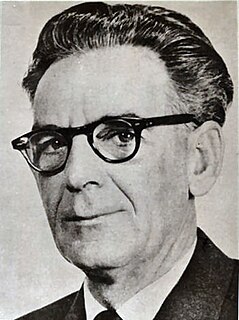Hans Charles Freeman AM, FAA was a German-born Australian bioinorganic chemist, protein crystallographer, and Professor of Inorganic Chemistry who spent most of his academic career at the University of Sydney. His best known contributions to chemistry were his work explaining the unusual structural, electrochemical, and spectroscopic properties of blue copper proteins, particularly plastocyanin. He also introduced protein crystallography to Australia and was a strong advocate for programs to ensure Australian scientists have good access to "big science" facilities. Freeman has received numerous honours, including being elected a Fellow of the Australian Academy of Science (FAA) and appointed a Member of the Order of Australia (AM) by the Australian Government. He was a charismatic lecturer who voluntarily continued teaching well into his formal retirement and imbued his students with a love of science.
The Australian Academy of Technology and Engineering is an independent thinktank that helps Australians understand and use technology to solve complex problems. It was founded in 1975 as one of Australia's four learned Academies.

Edward Henry Rennie was an Australian scientist and a president of the Royal Society of South Australia.
John Stuart Anderson FRS, FAA, was a British and Australian scientist who was Professor of Chemistry at the University of Melbourne and Professor of Inorganic Chemistry at the University of Oxford.

Francis Patrick John "Frank" Dwyer FAA was Professor of Chemistry, Australian National University, Canberra. He was one of the most distinguished scientists Australia has produced. At the time of his death in 1962 he was widely recognised as a leading authority in inorganic chemistry, and had laid the foundation in Australia for a new field of research bridging science and medicine—biological inorganic chemistry. His influence as a teacher and as a researcher was widespread.

Alan McLeod Sargeson FAA FRS was an Australian inorganic chemist.
Leonard Francis Lindoy, FAA, is an Australian chemist with interests in macrocyclic chemistry and metallo-supramolecular chemistry, and an Emeritus Professor of Inorganic Chemistry at the University of Sydney and James Cook University. He moved to the University of Sydney in 1996 to take up the departmental chair in inorganic chemistry vacated by Hans Freeman.
Athelstan Laurence Johnson Beckwith AO, FRS was an Australian chemist. He was a fellow of the Australian Academy of Science.
Anthony William (Tony) Thomas FAA is an Australian physicist, Professor of Physics at the University of Adelaide since 1984 and Elder Professor of Physics since 1990.
Richard Robson FAA is a Professor of Chemistry at the University of Melbourne. Robson has published over 200 articles, specialising in coordination polymers, a.k.a. metal-organic frameworks. He has been described as "a pioneer in crystal engineering involving transition metals".

David Henry Solomon is an Australian polymer chemist. He is best known for his work in developing Living Radical Polymerization techniques, and polymer banknotes.
Denis Oswald Jordan AO FAA FRACI was an Anglo-Australian chemist with a distinguished career as a researcher and lecturer in Chemistry at both University College Nottingham (1940–53) and the University of Adelaide, where he was Angas Professor of Chemistry from 1958 to 1982. Jordan also served as president of Australian Institute of Nuclear Science and Engineering from 1958 to 1962, and Royal Australian Chemical Institute from 1978 to 1979.
Raymond James Wood Le Fèvre DSc, FRACI, FAA, FRS was professor of chemistry at the University of Sydney from 1946 until his retirement in 1970. He was elected a Fellow of the Royal Australian Chemical Institute in 1946, a Foundation Fellow of the Australian Academy of Science in 1954, and a Fellow of the Royal Society in 1959. The University of Sydney awarded him an honorary D.Sc. in 1985.
Alexander Killen Macbeth CMG, DSc, FAA (1889–1957), generally called Killen or A. Killen Macbeth, was an Irish born academic and organic chemist who from 1928 until his retirement in 1954 was the Angas Professor of Chemistry at the University of Adelaide. In 1946 he was appointed a Companion of the Order of St Michael and St George, and in 1955 he was elected Fellow of the Australian Academy of Science.
Sir Geoffrey Malcolm Badger AO DSc FAA FRACI FTSE FACE FAIM was Professor of Organic Chemistry at the University of Adelaide from 1955 to 1964, and Vice-Chancellor of the University from 1967 to 1977. He was elected Fellow of the Australian Academy of Science in 1960, appointed an Officer of the Order of Australia in 1975, and was knighted in 1979. In retirement he wrote two books, "Explorers of the Pacific" (1988) and "The Explorers of Australia" (2001).
Professor Robert Kerford (Bob) Morton FAA was an Australian biochemist. He was Associate Professor of Biochemistry at the University of Melbourne from 1952 to 1958, and Professor of Agricultural Chemistry at the University of Adelaide's Waite Agricultural Research Institute from 1959 to 1962. In 1963 he became Professor of Biochemistry at Adelaide, but soon after his 43rd birthday died as the result of an accident in his laborary.
Charles William Shoppee FAA FRS (1904–1994) was a British-born organic chemist who performed major research into steroids. He was Professor of Chemistry at the University of Wales (1946–1956) and Professor of Organic Chemistry at the University of Sydney (1956–1969).




